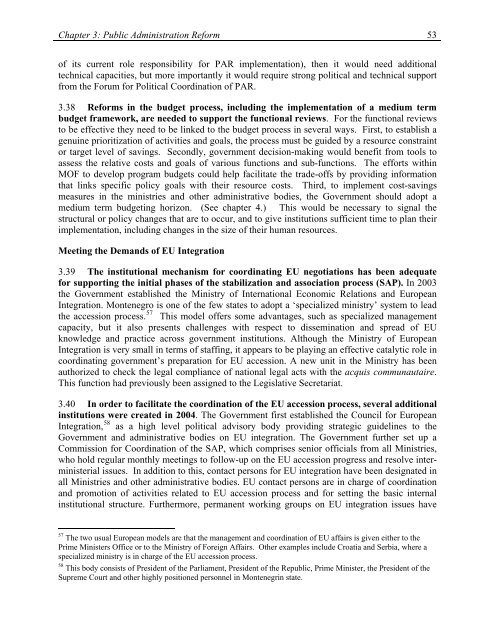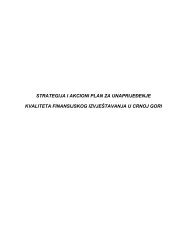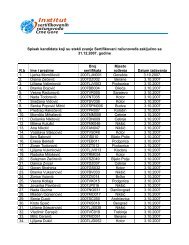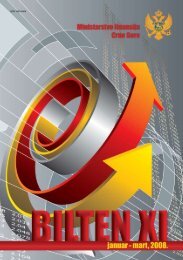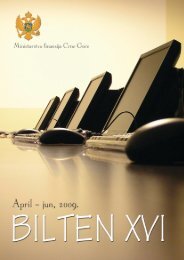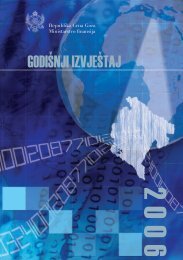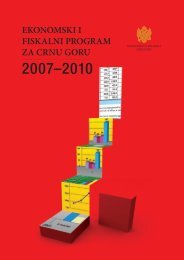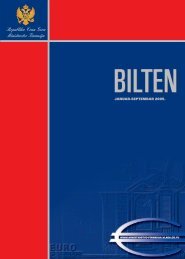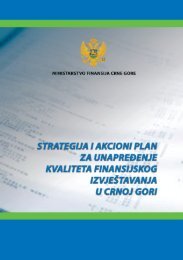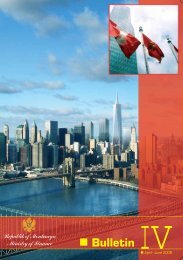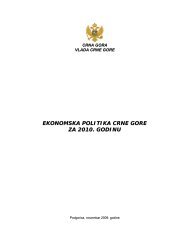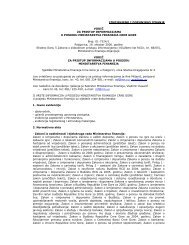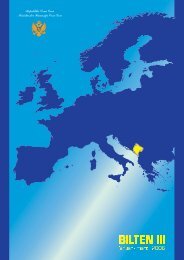Republic of Montenegro: Public Expenditure and ... - Vlada Crne Gore
Republic of Montenegro: Public Expenditure and ... - Vlada Crne Gore
Republic of Montenegro: Public Expenditure and ... - Vlada Crne Gore
You also want an ePaper? Increase the reach of your titles
YUMPU automatically turns print PDFs into web optimized ePapers that Google loves.
Chapter 3: <strong>Public</strong> Administration Reform 53<br />
<strong>of</strong> its current role responsibility for PAR implementation), then it would need additional<br />
technical capacities, but more importantly it would require strong political <strong>and</strong> technical support<br />
from the Forum for Political Coordination <strong>of</strong> PAR.<br />
3.38 Reforms in the budget process, including the implementation <strong>of</strong> a medium term<br />
budget framework, are needed to support the functional reviews. For the functional reviews<br />
to be effective they need to be linked to the budget process in several ways. First, to establish a<br />
genuine prioritization <strong>of</strong> activities <strong>and</strong> goals, the process must be guided by a resource constraint<br />
or target level <strong>of</strong> savings. Secondly, government decision-making would benefit from tools to<br />
assess the relative costs <strong>and</strong> goals <strong>of</strong> various functions <strong>and</strong> sub-functions. The efforts within<br />
MOF to develop program budgets could help facilitate the trade-<strong>of</strong>fs by providing information<br />
that links specific policy goals with their resource costs. Third, to implement cost-savings<br />
measures in the ministries <strong>and</strong> other administrative bodies, the Government should adopt a<br />
medium term budgeting horizon. (See chapter 4.) This would be necessary to signal the<br />
structural or policy changes that are to occur, <strong>and</strong> to give institutions sufficient time to plan their<br />
implementation, including changes in the size <strong>of</strong> their human resources.<br />
Meeting the Dem<strong>and</strong>s <strong>of</strong> EU Integration<br />
3.39 The institutional mechanism for coordinating EU negotiations has been adequate<br />
for supporting the initial phases <strong>of</strong> the stabilization <strong>and</strong> association process (SAP). In 2003<br />
the Government established the Ministry <strong>of</strong> International Economic Relations <strong>and</strong> European<br />
Integration. <strong>Montenegro</strong> is one <strong>of</strong> the few states to adopt a ‘specialized ministry’ system to lead<br />
the accession process. 57 This model <strong>of</strong>fers some advantages, such as specialized management<br />
capacity, but it also presents challenges with respect to dissemination <strong>and</strong> spread <strong>of</strong> EU<br />
knowledge <strong>and</strong> practice across government institutions. Although the Ministry <strong>of</strong> European<br />
Integration is very small in terms <strong>of</strong> staffing, it appears to be playing an effective catalytic role in<br />
coordinating government’s preparation for EU accession. A new unit in the Ministry has been<br />
authorized to check the legal compliance <strong>of</strong> national legal acts with the acquis communautaire.<br />
This function had previously been assigned to the Legislative Secretariat.<br />
3.40 In order to facilitate the coordination <strong>of</strong> the EU accession process, several additional<br />
institutions were created in 2004. The Government first established the Council for European<br />
Integration, 58 as a high level political advisory body providing strategic guidelines to the<br />
Government <strong>and</strong> administrative bodies on EU integration. The Government further set up a<br />
Commission for Coordination <strong>of</strong> the SAP, which comprises senior <strong>of</strong>ficials from all Ministries,<br />
who hold regular monthly meetings to follow-up on the EU accession progress <strong>and</strong> resolve interministerial<br />
issues. In addition to this, contact persons for EU integration have been designated in<br />
all Ministries <strong>and</strong> other administrative bodies. EU contact persons are in charge <strong>of</strong> coordination<br />
<strong>and</strong> promotion <strong>of</strong> activities related to EU accession process <strong>and</strong> for setting the basic internal<br />
institutional structure. Furthermore, permanent working groups on EU integration issues have<br />
57 The two usual European models are that the management <strong>and</strong> coordination <strong>of</strong> EU affairs is given either to the<br />
Prime Ministers Office or to the Ministry <strong>of</strong> Foreign Affairs. Other examples include Croatia <strong>and</strong> Serbia, where a<br />
specialized ministry is in charge <strong>of</strong> the EU accession process.<br />
58 This body consists <strong>of</strong> President <strong>of</strong> the Parliament, President <strong>of</strong> the <strong>Republic</strong>, Prime Minister, the President <strong>of</strong> the<br />
Supreme Court <strong>and</strong> other highly positioned personnel in Montenegrin state.


